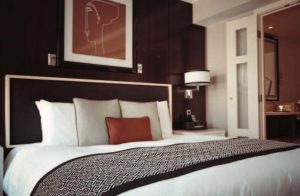
PHOTO: ERIKA WITTLIEB
These ideas pack a dècor punch!
By Janet Armstrong, Certified Interior Designer, CAPS | July/August 2019
For many of us, life changes such as the prospect of retirement or semi-retirement, perhaps even changing health, mean decisions regarding our homes. These life events often have us downsizing to smaller spaces that are easier to manage or to ‘lock and leave’ when the urge to travel strikes. While smaller spaces simplify our living situations, they can present a challenge in terms of how to make them comfortable and livable as well as stylish. With consideration of some simple ‘rules of thumb’, small spaces can have maximum style while appearing bright, spacious and open.
Furniture
Having multi-function furniture in your spaces means you can pack a lot of practical style into a room. Items such as a Murphy Bed that can fold up to the wall when not needed, means a spare bedroom can be a home office or den when you don’t have visitors. A stool or ottoman can be used as additional seating or an occasional table in living spaces and bench seating built into an alcove or along a wall can provide extra seating in the eating area.
Open legs on occasional tables and raised legs on sofas and chairs are ideal for a small space as they create a visual openness that makes a space appear larger.

PHOTO: SIMPLY SWANK DECOR
Furniture placement
When you are decorating a smaller space, do not shy away from a few simple large pieces of furniture with plain upholstery. These will have a bigger impact and make a statement in your space, whereas several smaller pieces clutter the room and busy patterns create too much visual busyness.
It is tempting to place furniture right against the walls to maximize the floor space in a small room. However, placing furniture an inch or two away from the walls creates the illusion of spaciousness. Also consider that while the space is small, placing furniture at an angle will encourage the eye to travel along the diagonal which is longer than the shortest wall and will make the room feel bigger. The added bonus with angled furniture is that this orientation creates room for a plant or lamp in the space behind the furniture piece.
Colour

PHOTO: OLICHEL ADAMOVICH
While many people think that light colours are de rigueur for small spaces, darker shades can create a feeling of coziness (rich brown, taupe or soft yellow) or bring drama to your spaces (cranberry red, dark gray). If you opt for a darker colour, keep it from overpowering the space by painting the trim and doors in a shade of white and keep accessories lighter too in terms of colour, texture and the number you use.
Regardless of the colours you select for the walls, keep your space feeling more expansive by minimizing the total number of colours and patterns used in your space. This will ensure a balanced and calm space and not create too much visual clutter and chaos.
Reflective or clear materials
The use of clear or reflective materials greatly increase the sense of space in a room and make it appear and feel open and airy. An item made of a clear material such as glass or acrylic, enables light to move throughout the space making it feel roomier. The use of mirrors (the jewels of a room) reflect light and make your space feel brighter and more alive.

Fabrics
To maximize lightness and spaciousness of your space, hang curtains constructed of a sheer fabric. Hanging draperies close to the ceiling and extending them to the floor will bring height to and visually enlarge your room. If you want a bit of pattern in your room, consider the use of fabrics with a simple and soft pattern such as a floral, stripes, vines or an open geometric pattern for draperies and throw cushions.
Lighting
Light is your best ally in making a small space feel bigger and more spacious. If you have natural light available in the space, open the draperies to their fullest extent and let the light in! If the natural light is insufficient or not available, provide lots of artificial light from lamps and ceiling fixtures and use LED bulbs which are more efficient at converting energy into light and provide better light distribution.
No matter the reason you are faced with decisions surrounding the layout and decor for a more manageable space, remember that you can have maximum style and impact in your smaller rooms! These simple guidelines will assist in decisions with respect to furniture, colour and decor and result in rooms that are spacious and expansive and pack a decor punch!
Janet Armstrong (simplyswankdecor.ca) is a graduate of the Interior Design Institute of Canada, CAPS (Certified Aging in Place Specialist) and a Director and Membership Chair with the Board of the Decorators and Designers Association of Canada (DDA Canada).






